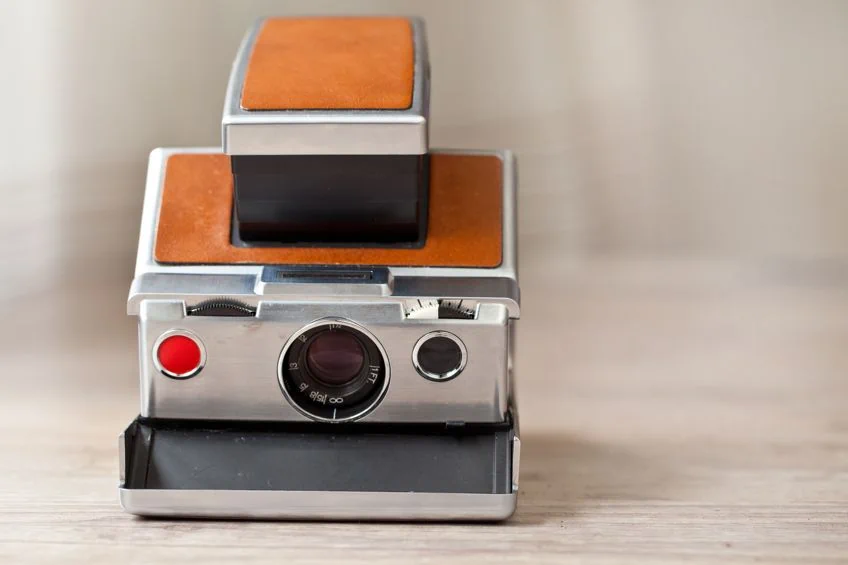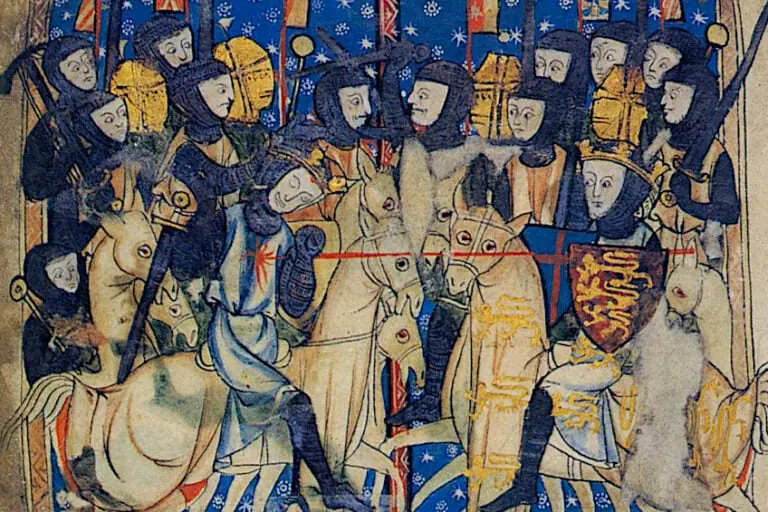History of Polaroid – The Making of the First Polaroid Camera
Today, there are many ways to capture important moments in life. Whether you’re using the camera on your smartphone or have a dedicated digital camera, capturing important moments has never been easier. However, this wasn’t always the case. Polaroid was one of the most innovative players in the instant photography game, but what exactly set them apart from the competition? Let’s have a look at how Polaroid got its start, what drove them to create the instant photo camera, what other products it had to offer, and who the man behind the world’s first Polaroid camera really is.
Contents
The History of Polaroid
The history of Polaroid bears a lot of similarities to other innovative and highly successful businesses of the time, with moments of triumph, huge financial success, scuffles with competitors, and the brand eventually becoming synonymous with the type of product they had produced. This being said, let’s have a look at how Polaroid got its start, who created the patented technology, and what eventually happened to the original company.
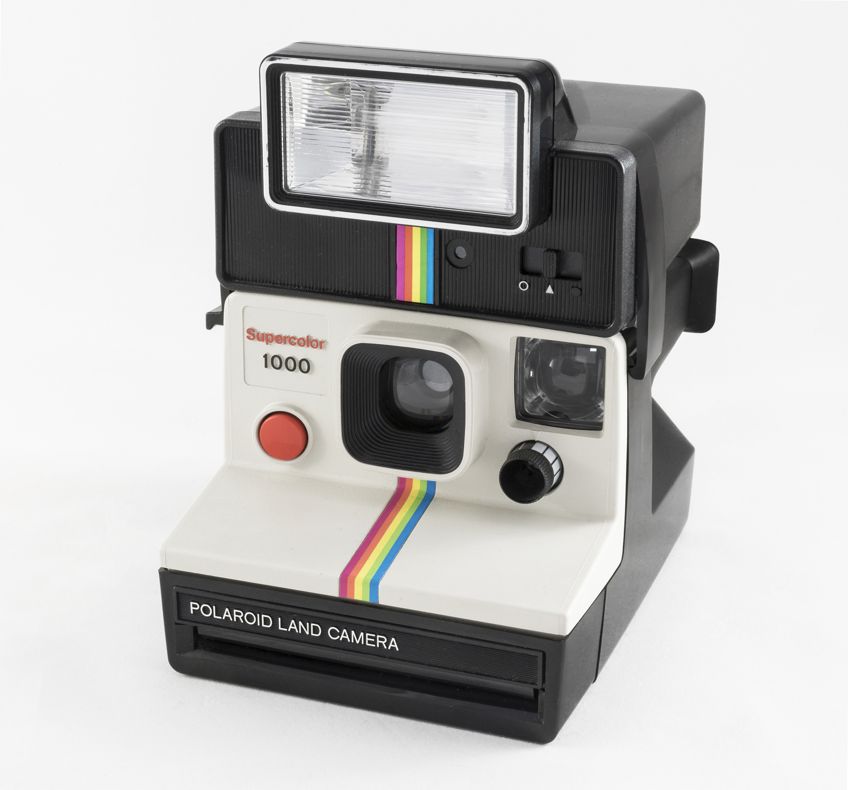 Polaroid Supercolor 1000; Jacek Halicki, CC BY-SA 4.0, via Wikimedia Commons
Polaroid Supercolor 1000; Jacek Halicki, CC BY-SA 4.0, via Wikimedia Commons
How Polaroid Got Its Start
Who created Polaroid cameras? The Polaroid company was registered and incorporated by Edwin Land and George W. Wheelwright all the way back in the year 1937. Polaroid did not start out producing the instant photo cameras that we all know and love today, but instead made their mark on the world by designing and producing polarized sunglasses, and protective goggles for dogs. Edwin Land was quite the pioneer in the field of polarizer technology, dropping out of Harvard as a freshman to pursue and develop the ideas he had about the possible applications he had for his discoveries. This led to polaroid developing some extremely useful technology during the second world war, including infrared night vision goggles and the 3-D movie.
Understanding how photons interact with certain materials and then finding useful applications for these interactions seems to have been at the forefront of the research Edwin Land had in mind. This combined with military contracts allowed Polaroid to invest in further research and development of their other interests.
Due to their success, various publications produced features on the genius and innovative products the Polaroid company had become synonymous with. Land would eventually go on to produce the first iteration of the instant film camera in the year 1947, just two years after the end of the second world war, and it was far cry from the sleek, smooth design we know today. Essentially, Land had managed to fit all the mechanisms of a dark room development studio into a little box. Unlike the modern polaroid camera, the operator had to release the film manually once the photo was taken, but the results were objectively still the same as they are today. For the next 20 years, Land would go on to research and develop his instant film camera in Cambridge, Massachusetts where Polaroid was founded and headquartered.
When Did Polaroid Cameras Come Out?
Knowing who created the polaroid cameras is all well and good, but when did polaroid cameras come out? Well, as we mentioned previously the first version of the polaroid camera was introduced in 1947, but this version was a prototype used as a sort of “proof of concept” for the general public. For the next 30 years, this type of polaroid camera involved the user releasing the photograph manually and peeling the negative away from the primary photograph. In the early ’70s, Land was featured on the cover of Time Magazine with the headline “A genius with his magic camera”. As many people have pointed out, this is eerily similar to the praise and media attention afforded to Steve Jobs upon the release of the first iPod and later on the iPhone 3G, and understandably so. Polaroid is often referred to as the Apple of its time.
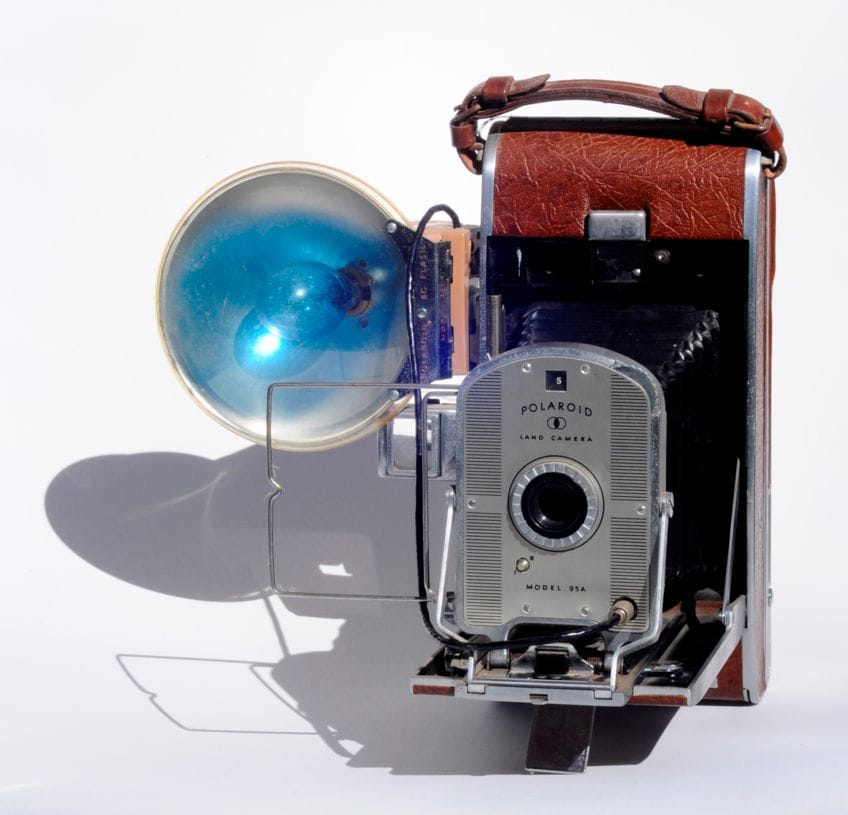 Polaroid Land Camera Model 95A; Jarek Tuszyński / CC-BY-SA-4.0, CC BY-SA 4.0, via Wikimedia Commons
Polaroid Land Camera Model 95A; Jarek Tuszyński / CC-BY-SA-4.0, CC BY-SA 4.0, via Wikimedia Commons
What drove Land to the invention of the instant film camera though? Was it a spin-off of an existing product? Was it an accident? No. According to Land himself, he was driven to develop the instant film camera when his three-year-old daughter asked him why she should not view the photo she had just taken. The development of the Polaroid instant film camera would continue thanks to new technologies and materials becoming readily available as time went on. Cameras became smaller, and easier to maintain, and the quality of the photographs improved noticeably as new and improved methods of capturing a photograph entered the market.
Polaroid vs. Kodak
The history of Polaroid cameras in late 70s turned into a breeding ground for conflict between various players in the photography and videography industry. One of the more notable buttings of heads came in 1976 when Kodak decided to enter the instant photography market by announcing their own instant development photography camera. This was almost immediately challenged by polaroid which sought to stop the production and sale of its competitor’s device entirely.
Polaroid claimed that Kodak has stolen its proprietary instant photography process that takes place inside the camera unit.
This lawsuit lasted for a full decade and Polaroid sought to attain 12 million US dollars for the patent infringement by Kodak, of which they were awarded 909.5 million US dollars by a court ruling. This suit took place on the federal level and has become a notable event in the history of instant photography. The history of the Polaroid camera is initially seen as a story of innovation and genius invention. Given that since the invention of the first instant developing camera, Polaroid had sold over seven million units, it’s easy to see why they were so quick to object to anyone infringing on their intellectual and proprietary property, even though there are many brands who offer instant developing cameras today.
The Early Decline of Polaroid
The history of the Polaroid camera in the late ’70s saw the company faced with rapid advancements in both photography and videography technology. Film-based home movie cameras were becoming increasingly popular, and Polaroid attempted to enter the market by offering them a Dufaycolor motion capture video camera named the “Polavision”. However, despite its unique design and recording medium, it simply could not compete with the broad appeal and accessibility of the video tape-based cameras that had flooded the market at this point. For many, this marked the beginning of the end of the golden age of Polaroid, as it saw a decline in market share and overall sales during this era.
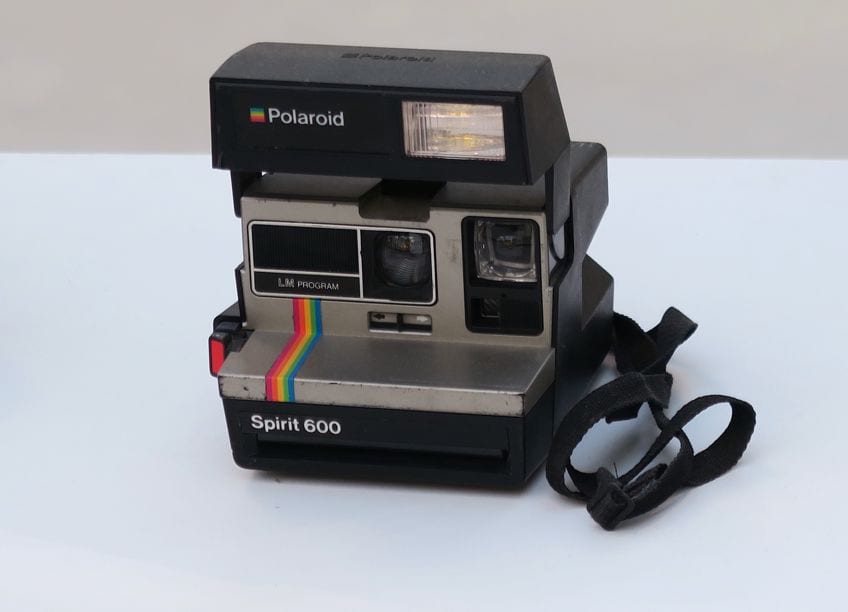 Polaroid Spirit 600; Malopez 21, CC BY-SA 4.0, via Wikimedia Commons
Polaroid Spirit 600; Malopez 21, CC BY-SA 4.0, via Wikimedia Commons
Failure of the Polavision
At this point in the history of Polaroid, the objective failure of Polavision as a product led to a number of changes inside the company. Due to a lack of sales, the company would be forced to essentially write off around 89 million US Dollars from the Polavision venture, however, the technology would later be used on the Polachrome instant slide film camera. During this period, Edwin Land would also be convinced to retire as head of the company and enter retirement. The start of a new decade (the 1980s) saw the company shift its focus to motion capture technology by introducing its very own line of polaroid video tapes and competing with existing players in the market.
This change came at quite a hefty price though as the company was forced to lay off quite a few employees and even close down a number of factories in order to successfully achieve this market pivot. However, the advent of both disposable film cameras and color photo development meant that there were even more markets that Polaroid would have to enter to remain competitive in the photography industry.
The 1990s and early 2000s saw a surge in the development and sale of digital cameras, yet another hurdle that polaroid would have to jump over in order to remain relevant in the photography and video and video capture market. Polaroid was actually one of the first companies to offer a digital camera for sale, but it didn’t sell as well as some of its competitors. During the same period, digital scanners and the technology needed to create them for commercial use became more readily available, resulting in photography companies scrambling to get a piece of the pie. However, Polaroid’s variation of these scanners failed to compete against other brands like Nikon and Minolta, which contributed to Polaroid declaring bankruptcy in the year 2001.
The New Polaroid Corporation
The year 2001 was a time of substantial change for people all over the world, and Polaroid was no exception. The Polaroid company and its subsidiary brands declared federal chapter 11 bankruptcy, and as a result, their assets had been sold to Bank One and One Equity Partners, who would later change their name to suit their new acquisition. They would come to be known as the Polaroid Holding Company. There was a lot of controversy surrounding this acquisition due to the fact that stockholders and those on retirement plans set out by the original Polaroid corporation were left with nothing. To make matters worse, executives received large bonuses, further causing public opinion of the new Polaroid corporation to sour.

Furthermore, a total of about 45 executives were granted these huge bonuses for doing nothing else except retaining their positions on the board. In the same breath, employees that held stock in the company were barred from selling their stake in the business before seeking other employment, which was widely criticized. This new arrangement saw loads of other contingencies take hold. One of the more notable changes was that the original Polaroid corporation was forced to change its name to Primary PDC, and would receive around 30% of the new and improved Polaroid parent company. This essentially left Primary PDC as nothing more than a shell extension of the main company, primarily responsible for administration. The 30% (give or take) was used to compensate any of the old companies’ unsecured creditors.
The Character Group and the Polaroid Brand
When the dust settled after the bankruptcy and acquisition of the Polaroid Holding Company, the Character Company was allowed exclusive rights to use the Polaroid brand in the sale of anything that they produced for about three years. This resulted in the production and sale of various products in the year 2002, including portable DVD players and digital cameras. After three years elapsed, the Polaroid holding company was purchased by the Peters Group Worldwide.
This company was well known for buying up well-known brand names from companies who had fallen on hard times to attain said brands. This predatory behavior was fairly common at the time (and still is in some circles).
At the same time, the manufacturing locations of The Polaroid Holding Company would be purchased by another conglomerate named Flextronics, who subsequently stopped manufacturing polaroid film (disgruntling brand loyal customers and moving the production of Polaroid digital cameras to China due to cheaper manufacturing costs and minimizing overheads. In the year 2007, the Polaroid Holding Company would once again file for chapter 11 bankruptcy on the federal level due to dwindling returns, and conveniently after a criminal investigation began against their then parent company Peters Group Worldwide. Specifically, the investigation intended to shed light on the company’s founder Tom Petters.
Polaroid’s Purchase by Gordon Brothers Brand LLC and Consumer Capital LP
Soon after declaring bankruptcy the polaroid company and all of its subsequent assets would be put on auction. This resulted in a number of companies fighting for the rights to the brand name and its patented technologies. A company known as Patriarch Partners was the forerunner for all of the rights, but would eventually bow out due to extensive litigation. Eventually, the rights to the brand as well as its products would be acquired through a joint venture between Gordon Brothers Brand LLC and Consumer Capital LP in the year 2009, who sought to split the company’s assets, but would eventually decide to allow much of the company to remain whole.
The majority of the company’s employees would stay on in their roles and the company would be renamed PLR IP Holdings, LLC.
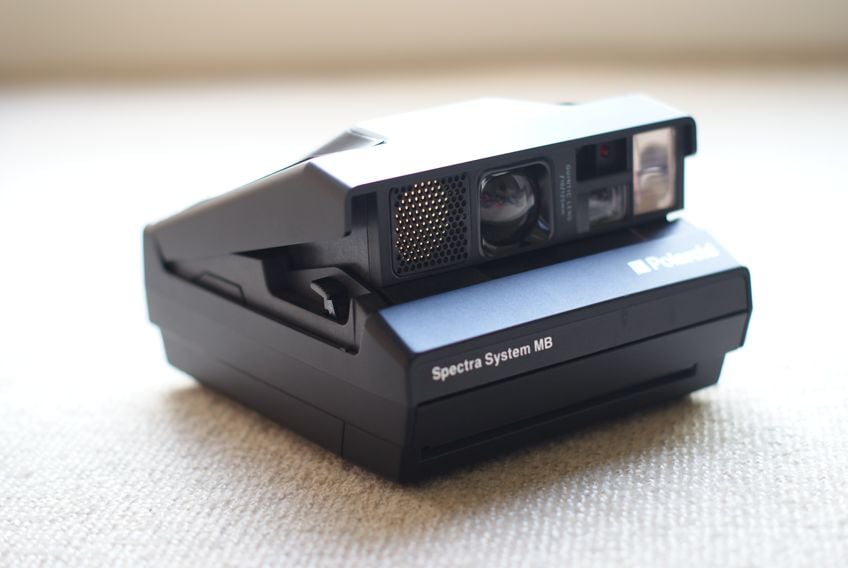 Polaroid Spectra System MB; 22Kartika, CC BY-SA 4.0, via Wikimedia Commons
Polaroid Spectra System MB; 22Kartika, CC BY-SA 4.0, via Wikimedia Commons
In the same year, PLR IP Holdings, LLC announced to the world that they would be entering into a five-year agreement with another company known as the Summit Global Group to produce their new and improved line of digital still cameras, video cameras, Go-Pro action cameras, and even digital photo frames! PLR IP Holdings, LLC expected $1.3, 000,000,000. In sales from this business deal, but did not specify the period in which they anticipated these returns.
The following year in 2010 PLR IP Holdings, LLC had yet another announcement to make that would increase its brand recognition.
They announced that the world-renowned recording artist Lady Gaga would be taking up the position of creative director within the company and that she would be the face of the brand going forward. This arrangement would last for four years, until 2014 when PLR IP Holdings, LLC announced that they would no longer be working with the artist.
Polaroid’s Purchase by the Smołokowski Family
Now that polaroid was back in the photography and videography business, it started to attract interested parties. Namely, it attracted the attention of the Smołokowski family, who were already well-acquainted with the brand and their first instant cameras. Smołokowski had actually picked up the production of Polaroid’s instant camera film when Polaroid itself ceased production back in the mid-2000s.
Smołokowski produced the instant film under the name “the impossible project”, which eventually became known as “Polaroid Originals”. Once the Smołokowski family successfully acquired the Polaroid brand, Polaroid Originals became known simply as Polaroid, effectively taking the company back to its roots while simultaneously paving the way for its future.
This acquisition happened in 2017, and two years later in 2019 the Polaroid website featured all new products including digital cameras, an instant film camera, their very own cube-shaped action camera, and even televisions! This would mark the first time in nearly a decade that Polaroid would be producing both instant film cameras as well as the film needed to operate them under the Polaroid brand. These products and the bearing of polaroid as a company have remained this way since the year 2020.
Polaroid’s Many Ventures and Partnerships
Throughout the history of the company, Polaroid entered into many ventures, sponsorships, and partnerships with companies all over the world. This comes as no surprise considering that their instant film cameras became quite popular not only in the US but internationally as well. This being said, let’s have a look at a few of the more notable ones.
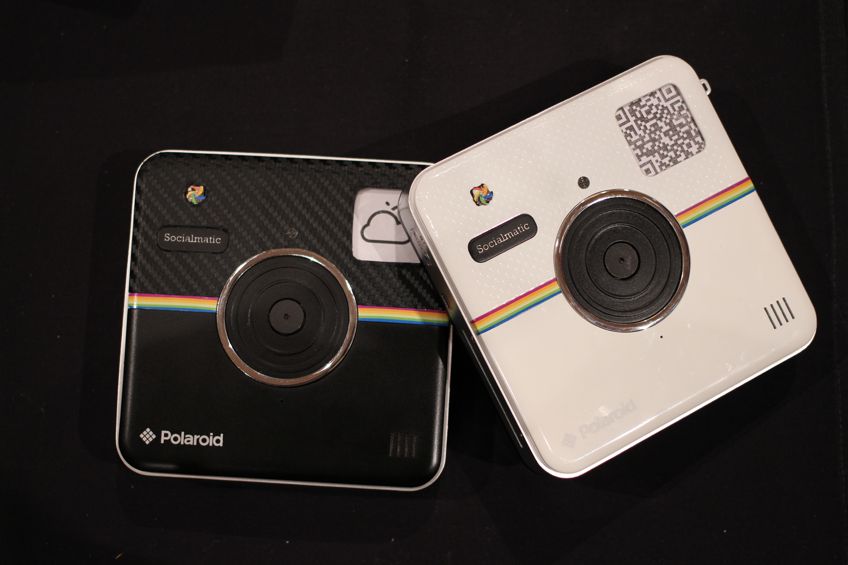 Polaroid Socialmatic; Maurizio Pesce from Milan, Italia, CC BY 2.0, via Wikimedia Commons
Polaroid Socialmatic; Maurizio Pesce from Milan, Italia, CC BY 2.0, via Wikimedia Commons
Sponsorships in Motorsports
Throughout the 1990s Polaroid was involved in a sponsorship deal with NASCAR for a few years, sponsoring various race series. One of the earliest events that they sponsored was the 125-mile race that came to be known as the “Polaroid 125”, a Featherlite Modified racing class that took place at the Watkins Glen international racing track in the year 1997. Back in the year 1992, Polaroid also sponsored a stock car racing series known as the Busch series, which took place on second-tier tracks and came to be known as the “X-Finity” racing series as can be seen by promotional material from the era.
If you’re something of a NASCAR fan then you’re likely aware of their sponsorship arrangement with one Shawna Robertson and their Oldsmobile in this series.
It wasn’t just NASCAR that Polaroid provided sponsorship for either. Polaroid would go on to sponsor a competitor in the IndyCar series as well, namely the number 42 Impala driven by Juan Pablo Montoya while he competed in the NASCAR Sprint Cup series. Their involvement also extended to the IRL IndyCar series, and the NOPI drift series.
Polaroid Branded Floppy Disks
If you think that Polaroid would limit itself to photo and video capture technology you’d be wrong. In addition to their transition to digital cameras, Polaroid would also venture into the lucrative data storage business, which makes sense considering that digital storage formed part of the digital camera market in which they found itself. Their launch took place during the 1980s and was actually described as a major brand in the market at the time by the New York Times.
Even though the product was of good quality, the publisher did note that the reputation of the brand was based on the fact that they sold other products, and their praise was not based on the merit of the disk’s quality alone.
 Polaroid Logo; Polaroid, CC BY-SA 4.0, via Wikimedia Commons
Polaroid Logo; Polaroid, CC BY-SA 4.0, via Wikimedia Commons
Polaroid would sell these floppy disks throughout the late 1980s but would eventually cease production in the year 1991 due to diminishing sales numbers and the fact that compact disks (CDs) were beginning to be the more popular choice when it came to data storage. During their floppy disk endeavor, Polaroid offered both the sale of these disks and data recovery in the case of corruption and/or damage in certain instances.
The disks in question were sold under the Polaroid and PerfectData banners, but they were fundamentally the same product. These have become something of a collector’s item for both media historians and collectors of vintage electronics, with examples of these being sold online for as much as $30,00 a pack depending on the condition.
Polaroid Branded Mobile Printers
The late 2000s were a period of gradual change in conventional analog technology and the developing digital versions that were growing ever more popular. In order to bridge the gap between their digital cameras and their instant film cameras that were synonymous with their brand, Polaroid introduced PoGo, their mobile instant photo printer. This was pretty revolutionary considering that it allowed you to print photos directly from your mobile phone, wherever you find yourself. The printer allowed you to connect a device to it either via a data transfer or via Bluetooth and then print your desired image on the spot. This being said, how this printer works is quite interesting.
Instead of implementing conventional ink printing or laser printing methods (which would have been far too large and too expensive), it used paper with dye crystals already embedded inside it.
This was quite popular upon its release in the year 2008, and in 2009 Polaroid released an updated version of the printer that included a five-megapixel camera, which allowed the user to be less reliant on their digital cameras or mobile phones being present. This was sort of reminiscent of the first Polaroid camera as it allowed the user to capture and print a physical picture on the spot, using a singular device. Later, Polaroid would develop digital instant cameras that largely resembled their analog predecessors, but it would be a long time before these would eventually come to market.
Polaroid Digital Photography
While Polaroid had gained its reputation by being the first company in the world to produce an instant film camera, by the late 1990s and the early 2000s digital cameras became far more popular than the instant film variety, resulting in the Polaroid holding company entering the digital still camera and digital film camera markets. Polaroid’s origins are rooted in innovating existing technologies, and they would do this once more in 2012 when they unveiled their first smart camera.
Essentially, this was a camera that unitized an android-based operating system, allowing for functionality far beyond simply taking photographs and videos.
It functioned much the same way that a modern android smartphone would, allowing the user to do things like check their emails, download compatible apps from the Google Play store, and much more. The hardware itself included a digital optical zoom with a limit of three times magnification, as well as a WiFi receiver, geotagging, 32GB of onboard memory, and an expandable memory slot for SD cards.

The Smart Camera also featured a touchscreen interface, which was unique for the time and made the user experience that much more pleasant. Polaroid would learn from the overall success of this venture and branch out into other types of photo and video-capturing devices, not to mention their ventures into smart accessories in the field of health and fitness too. One of their more notable modern cameras was unveiled in the year 2014. This would come to be known as the Polaroid cube, which was essentially an action camera that was (as you may have guessed) cube-shaped.
This was designed to compete with other high-speed roughed action cameras like the GoPro Hero series, which were very popular at the time.
The Polaroid Apartheid Controversy
If you are unsure about what Apartheid was, it was (essentially) a system of racial segregation found in South Africa. The system segregated people of color from white individuals in virtually every facet of life, including workplaces, eateries, residential areas, beaches, hospitals, playgrounds, sports, recreational spaces, churches, buses, trains, and even schools. This system stayed in place from the year 1948 all the way until 1994, when a combination of civil unrest, international pressure, and a number of sanctions forced the ruling party to step down.
This would pave the way for South Africa to have its first fair democratic election, in which people of all races and socio-economic classes were allowed to vote.
However, before this, people of color were required to carry a passbook with them at all times. Authorities would check this book when people of color entered “white only” areas while allowing them to identify individuals engaging in behavior they deemed to be “undesirable”. This passbook contained a photo identification document of the owner as well as other identifying information.

How does this relate to Polaroid? Well, Caroline Hunter and Ken Williams (her future husband) were employees of Polaroid during the height of the Apartheid regime, and they discovered their employer had been supplying photo IDs to both the police and the military for the production of the aforementioned passbook. Hunter and Williams would bring this to the attention of their employer by forming the Polaroid Revolutionary Workers Movement.
This movement sought to boycott the Polaroid company as a whole, and as a result, Polaroid ceased sales of any of its products to the South African government, which included both its military and police facets.
Polaroid made a promise to the PRWM stating that they would increase the wages of its workers and upskill those in lower positions of the company. However, this was not enough for the duo, who then testified in front of the United Nations in an attempt to advocate for other countries to boycott Polaroid and its products. Polaroid would eventually fire both Hunter and Williams, but they had very much made their point. Organizations that Polaroid had donated to in the past were now sending their donations to South Africa in support of the Anti-Apartheid movement, and the fact that Polaroid did business with a racist regime would become public knowledge in the year 1977.
Now that you know who created Polaroid, the history of polaroid cameras, what made the camera so special, how the rebirth of Polaroid cameras happened, where they are as a company today, and the many ups and downs in between, it’s time for you to get out there and put your newfound knowledge to the test! Polaroid has a colorful history and continues to create high-quality, innovative camera equipment to this day.
Frequently Asked Questions
Is Polaroid the Oldest Instant Camera?
Yes, Polaroid was the world’s first instant camera and saw huge success in the photography market after its inception. However, due to the advent of video tapes and digital cameras, Polaroid fell upon hard times in 2001. The rebirth of Polaroid cameras saw the company move with the times, and develop digital cameras and portable instant printers.
How Old Is the Polaroid Camera?
The first commercially available Polaroid camera went on sale in 1943, but a working concept of an instant camera was in use since the year 1937. This means that Polaroid (as both an instant camera and the concept of instant photography in general) is roughly 80 years old!
When Did People Stop Using Polaroids?
The truth is that many people never stopped using Polaroid cameras. The company that acquired Polaroid in 2007 stopped producing the instant film used by the cameras in 2009, which led to the decline of the camera’s use in favor of alternative brands, and eventually, digital photography.

I am deeply passionate about history and am constantly fascinated by the rich and complex stories of the past. As the editor-in-chief of learning-history.com, I have the opportunity to share this passion with a wide audience through the creation and distribution of engaging and informative content about historical events, persons, and cultures. Whether it’s through writing articles and blog posts or creating videos or podcasts, I strive to bring the past to life in a way that is both accurate and enjoyable. My expertise in history, combined with my strong writing and communication skills, allows me to effectively communicate complex historical concepts and make them accessible and interesting to a wide range of readers. I am truly grateful for the opportunity to share my love of history with others through my work on learning-history.com.

